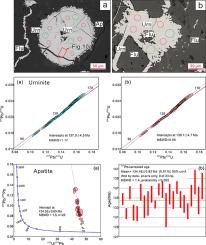复杂热液铀矿系统中铀矿U[sbnd]Pb时计稳健性评价——来自华南象山火山相关铀矿田的启示
IF 3.6
2区 地球科学
Q1 GEOCHEMISTRY & GEOPHYSICS
引用次数: 0
摘要
由于铀矿物(如铀矿)的复杂蚀变,使UPb同位素数据的解释复杂化,因此热液铀矿床的准确测年一直具有挑战性。本文利用原位LA-ICP-MS对中国南方象山火山相关铀矿田的铀矿进行了新的UPb定年,解决了这一问题。通过详细的岩石学观察和元素扫描,我们精心挑选了保存完好、受成矿后蚀变影响最小的铀矿粒/脉。铀矿UPb地质年代学结果精确可靠,经208pb校正的UPb年龄分别为137.0±4.5 Ma和139.1±4.7 Ma,与同一手标本的同期热液磷灰石UPb年龄(约135 Ma)具有显著的一致性。岩石学和元素填图分析表明,含铅矿物通常以微小颗粒沿微裂缝或蚀变铀矿颗粒边缘分布。Pb分布的非均质性可能是成矿后构造-热事件引起的流体辅助变质的结果,这种变质会导致同位素重置和Pb损失,从而导致UPb年龄不准确或误导性。此外,铀矿样品中大量异常含铅矿物(如含铅矿硫化钼、黄铁矿)的存在也可能导致UPb年龄小于预期。更重要的是,新的成矿年龄在误差范围内与火山岩就位年龄几乎相同。这种密切的时间匹配,结合铀矿的地球化学特征,强烈提示火山岩浆作用与铀矿化之间存在成因联系,表明象山铀矿田可能是在一个短暂而连续的成矿事件中形成的,而不是经过一个漫长而复杂的成矿事件序列。此外,本研究强调需要仔细解释地质复杂的铀或铀伴生矿系统中的铀矿UPb日期。本文章由计算机程序翻译,如有差异,请以英文原文为准。

Assessing the robustness of uraninite UPb chronometer in complex hydrothermal uranium ore systems: Insights from Xiangshan volcanic-related uranium ore field, South China
Accurate dating of hydrothermal uranium deposits has long been challenging due to the complex alteration of uranium minerals such as uraninite, which complicates the interpretation of U![]() Pb isotopic data. This study addresses this issue by presenting new U
Pb isotopic data. This study addresses this issue by presenting new U![]() Pb dating results from uraninite in the Xiangshan volcanic-related uranium ore field, South China, using in situ LA-ICP-MS. Through detailed petrographic observations and elemental scanning, we carefully selected well-preserved uraninite grains/veins that were minimally affected by post-mineralization alteration. The uraninite U
Pb dating results from uraninite in the Xiangshan volcanic-related uranium ore field, South China, using in situ LA-ICP-MS. Through detailed petrographic observations and elemental scanning, we carefully selected well-preserved uraninite grains/veins that were minimally affected by post-mineralization alteration. The uraninite U![]() Pb geochronology yields the precise and reliable 208Pb-corrected U
Pb geochronology yields the precise and reliable 208Pb-corrected U![]() Pb age of 137.0 ± 4.5 Ma and 204Pb-corrected U
Pb age of 137.0 ± 4.5 Ma and 204Pb-corrected U![]() Pb age of 139.1 ± 4.7 Ma, respectively, demonstrating remarkable consistency with the coeval hydrothermal apatite U
Pb age of 139.1 ± 4.7 Ma, respectively, demonstrating remarkable consistency with the coeval hydrothermal apatite U![]() Pb age (ca. 135 Ma) obtained from the same hand specimen. Petrographic and elemental mapping analyses show that Pb-bearing minerals are commonly distributed as tiny particles along the microfractures or within the margins of the altered uraninite grains. This heterogeneity of Pb distribution is likely a result of fluid-aided modification induced by post-ore tectono-thermal events, which causes isotopic resetting and Pb loss, leading to inaccurate or misleading U
Pb age (ca. 135 Ma) obtained from the same hand specimen. Petrographic and elemental mapping analyses show that Pb-bearing minerals are commonly distributed as tiny particles along the microfractures or within the margins of the altered uraninite grains. This heterogeneity of Pb distribution is likely a result of fluid-aided modification induced by post-ore tectono-thermal events, which causes isotopic resetting and Pb loss, leading to inaccurate or misleading U![]() Pb ages. In addition, the presence of a large amount of anomalous Pb-bearing minerals (e.g., Pb-bearing molybdenum sulfide, pyrite) within the uraninite samples can also lead to younger-than-expected U
Pb ages. In addition, the presence of a large amount of anomalous Pb-bearing minerals (e.g., Pb-bearing molybdenum sulfide, pyrite) within the uraninite samples can also lead to younger-than-expected U![]() Pb ages. More importantly, the new mineralization age is, within error, nearly identical to the volcanic rock emplacement ages. This close temporal match, coupled with the geochemical signature of the uraninite, strongly suggests a genetic link between volcanic magmatism and uranium mineralization, indicating the Xiangshan uranium ore field might be formed during a short but continuous mineralization event rather than through a protracted and complex sequence of mineralization episodes. Additionally, this study highlights the need for careful interpretation of uraninite U
Pb ages. More importantly, the new mineralization age is, within error, nearly identical to the volcanic rock emplacement ages. This close temporal match, coupled with the geochemical signature of the uraninite, strongly suggests a genetic link between volcanic magmatism and uranium mineralization, indicating the Xiangshan uranium ore field might be formed during a short but continuous mineralization event rather than through a protracted and complex sequence of mineralization episodes. Additionally, this study highlights the need for careful interpretation of uraninite U![]() Pb dates in geologically complex uranium or uranium-associated ore systems.
Pb dates in geologically complex uranium or uranium-associated ore systems.
求助全文
通过发布文献求助,成功后即可免费获取论文全文。
去求助
来源期刊

Chemical Geology
地学-地球化学与地球物理
CiteScore
7.20
自引率
10.30%
发文量
374
审稿时长
3.6 months
期刊介绍:
Chemical Geology is an international journal that publishes original research papers on isotopic and elemental geochemistry, geochronology and cosmochemistry.
The Journal focuses on chemical processes in igneous, metamorphic, and sedimentary petrology, low- and high-temperature aqueous solutions, biogeochemistry, the environment and cosmochemistry.
Papers that are field, experimentally, or computationally based are appropriate if they are of broad international interest. The Journal generally does not publish papers that are primarily of regional or local interest, or which are primarily focused on remediation and applied geochemistry.
The Journal also welcomes innovative papers dealing with significant analytical advances that are of wide interest in the community and extend significantly beyond the scope of what would be included in the methods section of a standard research paper.
 求助内容:
求助内容: 应助结果提醒方式:
应助结果提醒方式:


